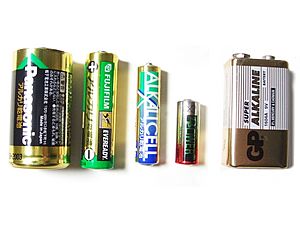Alkaline battery facts for kids
An alkaline battery is a special kind of battery that you can only use once. It's like a one-time power pack for your gadgets! These batteries are super common. You've probably seen them from brands like Duracell, Rayovac, or Energizer. They're often used in everyday items, taking the place of older battery types.
You can find alkaline batteries in many different sizes. Some common ones are AAA, AA, C, D, and 9V. There are also tiny ones for things like watches and calculators. Inside the battery, a chemical reaction happens. Zinc metal reacts with manganese dioxide in a special liquid called potassium hydroxide. This reaction creates the electricity that powers your devices.
Contents
How Alkaline Batteries Work
Alkaline batteries create electricity through a chemical process. This process involves a few key parts inside the battery.
The Main Ingredients
- Zinc: This metal acts as one of the main parts that react. It gives away electrons during the chemical process.
- Manganese Dioxide: This is another key material. It takes in the electrons that the zinc gives off.
- Potassium Hydroxide: This is a liquid called an electrolyte. It helps the electrons move between the zinc and the manganese dioxide. Think of it like a bridge for the tiny electrical particles.
The Chemical Reaction
When you use an alkaline battery, the zinc inside slowly changes. It combines with the potassium hydroxide. At the same time, the manganese dioxide also changes. This whole process creates a flow of electrons. This flow is what we call electricity. Because the chemicals are used up, you can't recharge these batteries. Once they're empty, they stop working.
Common Uses and Sizes
Alkaline batteries are incredibly popular because they work well in many devices. They are also quite affordable.
Everyday Devices
You can find alkaline batteries powering many things around your home. They are great for items that need a steady but not super strong power source.
- Remote Controls: Most TV remotes use AA or AAA alkaline batteries.
- Flashlights: Many flashlights, from small ones to larger ones, use AA, C, or D batteries.
- Toys: Lots of battery-powered toys use alkaline batteries to make them move or light up.
- Clocks: Wall clocks and alarm clocks often rely on a single AA battery.
- Small Electronics: Things like computer mice, wireless keyboards, and some portable radios use them.
Different Shapes and Sizes
Alkaline batteries come in a variety of shapes and sizes to fit different devices.
- AA and AAA: These are the most common sizes. AA batteries are slightly larger and often used in remotes and small toys. AAA batteries are thinner and used in smaller devices.
- C and D: These are larger batteries. They are used in bigger flashlights, boomboxes, and some larger toys.
- 9V: This battery has a rectangular shape with two terminals on top. It's often used in smoke detectors and some musical instruments.
- Button Cells: These are tiny, flat, round batteries. They are used in watches, calculators, small medical devices, and some hearing aids.
Why Alkaline Batteries are Popular
Alkaline batteries became very popular because they offered a big improvement over older types of batteries. They last longer and provide more power for their size. This made them a great choice for many everyday items. They are also easy to find in almost any store.
Images for kids
-
Thomas Edison's nickel–iron batteries manufactured under the "Exide" brand, originally developed in 1901 by Thomas Edison used a potassium hydroxide electrolyte.
-
Several sizes of button and coin cells. Some are alkaline and others are silver oxide. Two 9 V batteries were added as a size comparison. Enlarge to see the size code markings.
See also
 In Spanish: Pila alcalina para niños
In Spanish: Pila alcalina para niños





